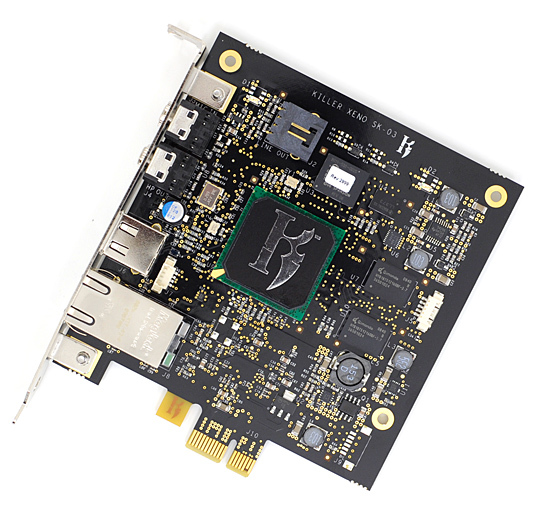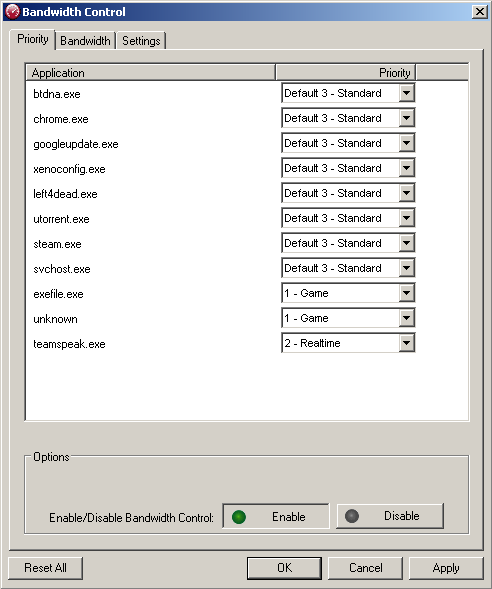EVGA Killer Xeno Pro: The Impact of Network Offloading
by Derek Wilson on July 3, 2009 4:20 AM EST- Posted in
- Networking
The Card and Features
This card sports a 400MHz PowerPC processor with 128MB of RAM, essentially making the Killer Xeno Pro a computer on a x1 PCIe board. As with the first generation, the major feature of the Killer Xeno Pro is it's ability to offload TCP/IP work from the CPU by bypassing the Windows TCP/IP stack.
Microsoft's built-in TCP/IP stack requires the CPU to handle network packet processing. Additionally, when packets arrive, they don't generate interrupts and applications must poll for data (which also wastes time and resources). Bigfoot Networks claims that the windows networking stack is not designed for low latency operation while the Killer Xeno Pro is. Regardless of how (or how efficiently) a software network stack is implemented, having it run in hardware will reduce overhead and impact on the rest of the system. It should also be noted that, for applications which require the windows networking stack (like some VPN products), the Killer Xeno Pro can disable it's "game mode" and enable "application mode" which does disable TCP/IP offload and can increase compatibility in some cases.
Adding to this, the Killer Xeno Pro hardware is capable of offloading other network centric tasks like VoIP, firewalls, and networked storage (though these features are not all fully supported with appropriate software at this point in time).

Installing the hardware is very straight forward, as it's just a simple PCIe card. If you want to use the voice chat features, the only additional need is to connect either the internal or external audio cable. No power is required, and other than that the network port is all that you'll need to worry about. Despite the fact that there is a USB port on the card, it is not used for anything at this point (but Bigfoot has indicated future potential to enable hardware managed USB attached storage).

Mic in and audio line out on a NIC; now that's a first.
The only installation issue we noted is that the driver install, when necessary, will also flash the Killer Xeno Pro hardware. There isn't very much warning about what's going to happen and no confirmation dialog before the start of the flash process. Those who click through install programs quickly without reading them might get themselves into a bit of trouble. There is no way to cancel the flash update once it's started, and while flashing hardware isn't as risky these days, it might be nice if the drivers were a little more clear about what was going to happen.

Easy mode switching.
The hardware comes with drivers and a tray application that are capable of bandwidth throttling and prioritization. Control can be down to a per application basis and maximum download and upload speeds can be specified. Or for benefit without the headache, applications can be prioritized allowing hardware and usage patterns to determine effective bandwidth. Unfortunately, the drivers and applications for the Killer Xeno Pro only run on Microsoft Windows operating systems (XP and Vista flavors). With the gaming focus, this makes sense, but it would still be nice for those who like to dualboot Mac OS X or Linux.

Per application QoS.

Per application bandwidth limits.
With software support, games and voice chat software can completely delegate any VoIP functionality to the Killer Xeno Pro which would handle taking input from the microphone (which plugs straight into the Killer Xeno Pro), compressing the data and sending it out over the network. When a voice packet is received by the Killer Xeno Pro, it decompresses it and sends it straight to the sound card (either via the soundcard's line-in port or an internal cable) bypassing the rest of the system completely. This should help reduce CPU overhead and voice lag caused by sources other than the network or server.
While this is great from a geeky technical standpoint, there isn't a huge amount of overhead on modern CPUs for voice chat software, and the network is by far the largest source of delay. So the actual benefit isn't going to be huge. These issues are the same with hardware firewall, bandwidth control, and all the extras.
The TCP/IP offload capability of the hardware will definitely remove another task from the CPU and operating system. This will free up resources that could be useful for other things, but the real world benefit of this will be very small in most games where the majority of the work is done on the GPU rather than the CPU. Having an NPU (network processing unit, as Bigfoot Networks likes to call it) that handles TCP/IP processing as soon as packets are received and uses hardware interrupts to let a game know that network packets have arrived (rather than requiring polling) can help decrease the latency between when a packet is received by the network card and when a game is able to make use of it, but as with the voice issue the largest delay is inherent in the internet itself and there is only so much benefit that can be had by optimizing the client side.
Not to say that optimizing client side networking is a bad thing: it certainly is not. The real question here is not whether the Killer Xeno Pro does something useful (because it does), the question is whether that useful thing has any significant impact on experience (and if that impact is high enough to justify the price).










121 Comments
View All Comments
DerekWilson - Friday, July 3, 2009 - link
So ... I looked it up ... (search for something like wow port usage or wow port forwarding or something)It seems that everywhere I look, the internet tells me that WoW uses TCP over port 3724 ...
I looked up EVE and it was a little harder to find info on -- but it looks to me like it uses both TCP and UDP for different things. Here's what I saw:
UDP ports 26001, 3478 and 5060-5062
TCP ports 26000, 80 and 443
EVE definitely uses UDP for it's voice support and it seems like it requires both UDP and TCP ports for other game data.
...
Additionally, the Killer Xeno Pro software only detects applications that use UDP and not applications that use only TCP ... so it makes sense that if it cannot detect WoW that WoW would be using TCP ... and if it detects EVE then EVE must be using UDP for at least something.
If you still think WoW uses UDP and EVE uses only TCP then please post links to your sources ...
mesiah - Saturday, July 4, 2009 - link
Strange how the wise ass know it alls disappear right after you hit them with facts. Its one thing for someone to come in and inform you that you got a point wrong in your review and back it up with sources. Its another for you trolls to show up, tout your epic knowledge you got from "the dude that made this shit." and then spit on the people that took the time to do the review. First, what is the point of reading the article if the only reason you are here is to give the writer grief? And second, If you thought you could do a better job maybe you should write you own articles so we can come and piss in your cheerios.Flawed or not, thanks for taking the time to do the article Derek and show us some real world numbers.
crimson117 - Friday, July 3, 2009 - link
I looked it up too!WoW similarly uses TCP for gameplay and UDP for voice support:
From http://us.blizzard.com/support/article.xml?locale=...">http://us.blizzard.com/support/article....cleId=21...
What do I need to know about ports?
Anytime your computer receives incoming data, it is sent to a "port". Your computer has many ports that can receive data, and different activities will utilize different ports. World of Warcraft & Burning Crusade use TCP port numbers 1119 and 3724 to play, and UDP port 3724 for in game Voice chat. The Blizzard Downloader, which downloads patches, also uses TCP ports 6112 and the range 6881-6999. For walkthroughs on router and firewall configuration you can use the Networking Help for the Blizzard Downloader page.
ShannonG - Saturday, January 30, 2010 - link
It is hard to believe any major MMORPG uses TCP for situational updates. Logging in, updates, billing, web, etc... sure.But for for game updates? 90% of it is real-time and redundant.
I don't play WoW, but if you routinely experience "warping" now you know why - craptastic network architecture.
A MMORPG with a well-designed network infrastructure will use a [custom] selectively-reliable UDP protocol, colloquially referred to as "RUDP".
If the card actually could/does off-load the networking stack [including firewalling et. al.] you stand to recapture 5%-10% of the CPU if it is bandwidth intensive.
Most games are not bandwidth intensive, quite the opposite; and it cannot significantly improve latency - that latency delays of the Internet will swamp the latency delays of packet delivery (ms vs us).
What this card will do is move the packet processing from whatever system bus your NIC is currently on to the ePCI bus. That's probably not a good thing either - the video card is on that bus.
Stas - Friday, July 3, 2009 - link
Given the return on the investment, I would pay $25 for this NIC at the most. Not $100+ (shit, I might as well go for an Intel dual Gigabit LAN NIC, if I'm to spend over $100).DerekWilson - Friday, July 3, 2009 - link
There is typically a baseline cost to add-in network hardware ... if you need something to put in your box, you'll probably spend at least $25-$30 just to get something equivalent to what's on most motherboards.bigboxes - Friday, July 3, 2009 - link
I just replaced my gigabit card on my file server with a new Linksys gigabit card. $30. No, my mobo only had 10/100, so I had to purchase the card. I remeber that D-Link's was $25 and Netgear was $20. The U.S. Robotics card was $15, but seeing as that was the card that just failed I tried the Linksys route.DerekWilson - Friday, July 3, 2009 - link
So maybe $20 - $30 ... :-) but still, you've got to pay something for just the PCB, the port, and the chips ... I certainly agree that for what it delivers in realized performance the $100 premium is too much for the Killer Xeno Pro ... but it is definitely more reasonable than their first offering.Shadowmage - Friday, July 3, 2009 - link
This is a horribly misleading article. The claim is that the card is better than standard networking cards, yet the author never tests the card against its competitors - add-in card NICs.Would you test a new graphics card against integrated graphics?
CptTripps - Tuesday, July 7, 2009 - link
How is it misleading? The author states that even tested against an integrated NIC there was no noticable difference. He then suggested we save our money.The "Claim" comes from the manufacturer and the result posted in the article is what I expected.